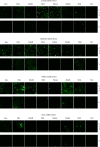Differential Infectivity of Human Neural Cell Lines by a Dengue Virus Serotype-3 Genotype-III with a Distinct Nonstructural Protein 2A (NS2A) Amino Acid Substitution Isolated from the Cerebrospinal Fluid of a Dengue Encephalitis Patient
- PMID: 36704099
- PMCID: PMC9873433
- DOI: 10.1155/2023/2635383
Differential Infectivity of Human Neural Cell Lines by a Dengue Virus Serotype-3 Genotype-III with a Distinct Nonstructural Protein 2A (NS2A) Amino Acid Substitution Isolated from the Cerebrospinal Fluid of a Dengue Encephalitis Patient
Abstract
Dengue encephalitis is considered as a severe but unusual clinical presentation of dengue infection. Limited molecular information is available on the neurotropism of dengue virus (DENV), highlighting the need for further research. During a dengue outbreak in Vietnam in 2013, two DENV-3 strains were isolated, in which one was isolated from cerebrospinal fluid (CSF) samples from a dengue encephalitis patient and another strain was isolated from a patient with classical dengue fever in Hai Phong, Vietnam. DENV serotype-3 (DENV-3) isolated from these samples belonged to genotype III, marking the first report of this genotype in the country at that time. Genetic variation between both strains was elucidated by using a full genome sequencing by next-generation sequencing (NGS). The infectivity of the isolated DENV-3 strains was further characterized using human and mouse neuronal cell lines. Phylogenetic analysis of the isolates demonstrated high homogeneity between the CSF-derived and serum-derived DENV-3, in which the full genome sequences of the CSF-derived DENV-3 presented a Thr-1339-Ile mutation in the nonstructural 2A (NS2A) protein. The CSF-derived DENV-3 isolate grew preferentially in human neuronal cells, with a significant proportion of cells that were positive for nonstructural 1 (NS1), nonstructural 4B (NS4B), and nonstructural 5 (NS5) antigens. These results suggest that NS2A may be a crucial region in the neuropathogenesis of DENV-3 and its growth in human neuronal cells. Taken together, our results demonstrate that a CSF-derived DENV-3 has unique infectivity characteristics for human neuronal cells, which might play a crucial role in the neuropathogenesis of DENV infection.
Copyright © 2023 Minh Huong Phu Ly et al.
Conflict of interest statement
The authors declare that they have no conflicts of interest.
Figures





Similar articles
-
Complete genome analysis and characterization of neurotropic dengue virus 2 cosmopolitan genotype isolated from the cerebrospinal fluid of encephalitis patients.PLoS One. 2020 Jun 18;15(6):e0234508. doi: 10.1371/journal.pone.0234508. eCollection 2020. PLoS One. 2020. PMID: 32555732 Free PMC article.
-
Isolation of dengue serotype 3 virus from the cerebrospinal fluid of an encephalitis patient in Hai Phong, Vietnam in 2013.J Clin Virol. 2015 Sep;70:93-96. doi: 10.1016/j.jcv.2015.07.295. Epub 2015 Jul 17. J Clin Virol. 2015. PMID: 26305828 Review.
-
Whole genome sequencing and genetic variations in several dengue virus type 1 strains from unusual dengue epidemic of 2017 in Vietnam.Virol J. 2020 Jan 20;17(1):7. doi: 10.1186/s12985-020-1280-z. Virol J. 2020. PMID: 31959201 Free PMC article.
-
Comparative whole genome analysis of dengue virus serotype-2 strains differing in trans-endothelial cell leakage induction in vitro.Infect Genet Evol. 2017 Aug;52:34-43. doi: 10.1016/j.meegid.2017.04.022. Epub 2017 Apr 27. Infect Genet Evol. 2017. PMID: 28456663
-
Molecular characterisation and phylogenetic analysis of dengue outbreak in Pasighat, Arunachal Pradesh, Northeast India.Indian J Med Microbiol. 2018 Jan-Mar;36(1):37-42. doi: 10.4103/ijmm.IJMM_17_30. Indian J Med Microbiol. 2018. PMID: 29735824
Cited by
-
Unexpected Predictors of Mortality During a DENV-3 Outbreak in Western Mexico: Seizures, Polyserositis, and Renal Dysfunction Without Severe Thrombocytopenia.Viruses. 2025 Jul 4;17(7):950. doi: 10.3390/v17070950. Viruses. 2025. PMID: 40733567 Free PMC article.
-
Central and Peripheral Nervous System Manifestations Associated with Dengue Illness.Viruses. 2024 Aug 28;16(9):1367. doi: 10.3390/v16091367. Viruses. 2024. PMID: 39339843 Free PMC article. Review.
References
-
- Pancharoen C., Thisyakorn U. Neurological manifestations in dengue patients. Southeast Asian Journal of Tropical Medicine and Public Health . 2001;32(2):341–345. - PubMed
-
- Sanguansermsri T P. B., Phornphutkul B., Kulapongs P., Tantachamrun T. Acute Encephalopathy Associated with Dengue Infection . Bangkok, Thailand: SEAMEO TROPMED; 1976.
LinkOut - more resources
Full Text Sources
Research Materials

